Family At
Page 60
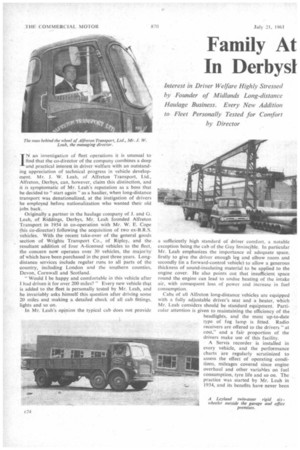
Page 61
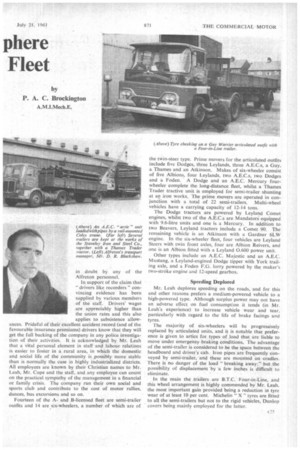
Page 62
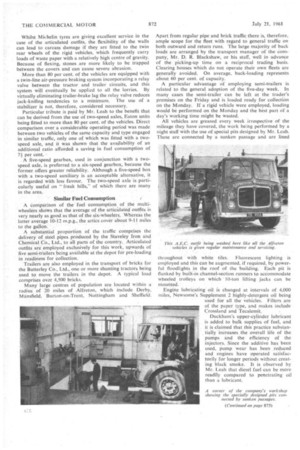
Page 67
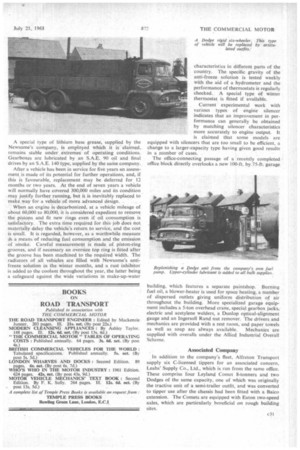
Page 68
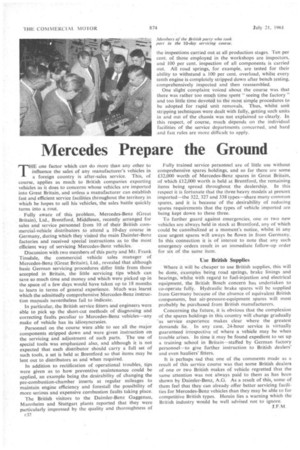
If you've noticed an error in this article please click here to report it so we can fix it.
In Derbyst
Interest in Driver Welfare Highly Stressed by Founder of Midlands Long-distance Haulage Business. Every New Addition to Fleet Personally Tested for Comfort by Director
IN an investigation of fleet operations it is unusual to find that the co-director of the company combines a deep and practical interest in driver welfare with an outstanding appreciation of technical progress in vehicle development. Mr. J. W. Leah, of Alfreton Transport, Ltd., Alfreton, Derbys, can, however, claim this distinction, and it is symptomatic of Mr. Leah's reputation as a boss that he decided to " start again " as a haulier, when long-distance transport was denationalized, at the instigation of drivers he employed before nationalization who wanted their old jobs back.
Originally a partner in the haulage company of J. and G. Leah, of Riddings, Derbys, Mr. Leah founded Alfreton Transport in 1954 in co-operation with Mr. W. E. Cope (his co-director) following the acquisition of two ex-B.R.S. vehicles. With the recent take-over of the general goods section of Wrights Transport Co.. of Ripley, and the resultant addition of four A-licensed vehicles to the fleet, the concern now operates over 30 vehicles, the majority of which have been purchased in the past three years. Longdistance services include regular runs to all parts of the country, including London and the southern counties, Devon, Cornwall and Scotland.
Would I be happy and comfortable in this vehicle after I had driven it for over 200 miles? " Every new vehicle that is added to the fleet is personally tested by Mr. Leah, and he invariably asks himself this question after driving some 20 miles and making a detailed check of all cab fittings, lights and so on.
In Mr. Leah's opinion the typical cab does not provide a sufficiently high standard of driver comfort, a notable exception being the cab of the Guy Invincible, In particular Mr. Leah emphasizes the importance of adequate space, firstly to give the driver enough leg and elbow room and secondly (in a forward-control vehicle) to allow a generous thickness of sound-insulating material to be applied to the engine cover. He also points out that insufficient space round the engine can lead to undue heating of the intake air, with consequent loss of power and increase in fuel consumption.
Cabs of all Alfreton long-distance vehicles are equipped with a fully adjustable driver's seat and a heater, which Mr. Leah considers should be standard equipment. Particular attention is given to maintaining the efficiency of the headlights, and the most up-to-date type of fog lamp is fitted. Radio receivers are offered to the drivers "at cost," and a fair proportion of the drivers make use of this facility.
A Servis recorder is installed in every vehicle, and the performance charts are regularly scrutinized to assess the effect of operating conditions, mileages covered since engine overhaul and other variables on fuel consumption, tyre life and so on. The practice was started by Mr. Leah in 1934, and its benefits have never been in doubt by any of the Alfreton personnel.
In support of the claim that drivers like recorders" convincing evidence has been supplied by various members of the staff. Drivers' wages are appreciably higher than the union rates and this also applies to subsistence allowances. Prideful of their excellent accident record (and of the favourable insurance premiums) drivers know that they will get the full backing of the company in any police investigation of their activities. It is acknowledged by Mr. Leah that a vital personal element in staff and labour relations is easier to foster in a rural area, in which the domestic and social life of the community is possibly more stable than is normally the case in highly industrialized districts. All employees are known by their Christian names to Mr. Leah. Mr. Cope and the staff, and any employee can count on the practical sympathy of the management in a financial or family crisis. The company run their own social and sports club and contribute to the cost of motor rallies, dances, bus excursions and so on.
Fourteen of the Aand B-licensed fleet are semi-trailer outfits and 14 are .six-wheelers, a number of which are of
the twin-steer type. Prime movers for the articulated outfits include five Dodges, three Leylands, three A.E.C.s, a Guy, a Thames and an Atkinson. Makes of six-wheeler consist of five Albions, four Leylands, two A.E.C.s, two Dodges and a Foden. A Dodge and an A.E.C. Mercury fourwheeler complete the long-distance fleet, whilst a Thames Trader tractive unit is employed for semi-trailer shunting at an iron works. The prime movers are operated in conjunction with a total of 22 semi-trailers. Multi-wheel vehicles have a carrying capacity of 12-14 tons.
The Dodge tractors are powered by Leyland Comet engines, whilst two of the A.E.C.s are Mandators equipped with 9.6-litre units and one is a Mercury. In addition to two Beavers, Leyland tractors include a Comet 90. The remaining vehicle is an Atkinson with a Gardner 6LW engine. In the six-wheeler fleet, four vehicles are Leyland Steers with twin front axles, four are Albion Reivers, and one is an Albion fitted with a Leyland 0.600 power unit.
Other types include an A.E.C. Majestic and an A.E.C. Mustang, a Leyland-engined Dodge tipper with York trailing axle, and a Foden F.G. lorry powered by the maker's two-stroke engine and 12-speed gearbox.
Speeding Deplored
Mr. Leah deplores speeding on the roads, and for this and other reasons prefers a medium-powered vehicle to a high-powered type. Although surplus power may not have an adverse effect on fuel consumption it tends (in Mr. Leah's experience) to increase vehicle wear and tear. 'particularly with regard to the life of brake facings and tyres.
The majority of six-wheelers will be progressively replaced by articulated units, and it is notable that preference is given to artics for types of load that are liable to move under emergency braking conditions, The advantage of the semi-trailer is considered to be the space between the headboard and driver's cab. Iron pipes are frequently conveyed by semi-trailer, and these are mounted on cradles. There is no danger of the load "breaking away:" but the possibility of displacement by a few inches is difficult to eliminate.
In the main the trailers are B.T.C. Four-in-Line, and this wheel arrangement is highly commended by Mr. Leah. the most important gain provided being a reduction in tyre wear of at least 10 per cent. Michelin " X tyres are fitted to all the semi-trailers but not to the rigid vehicles, Dunlop covers being mainly employed for the latter. Whilst Michelin tyres are giving excellent service in the case of the articulated outfits, the flexibility of the walls can lead to carcass damage if they are fitted to the twin rear wheels of the rigid vehicles, which frequently carry loads of waste paper with a relatively high centre of gravity. Because of flexing, stones are more likely to be trapped between the covers and can cause severe abrasion.
More than 80 per cent, of the vehicles are equipped with a twin-line air-pressure braking system incorporating a relay valve between the tractor and trailer circuits, and this system will eventually be applied to all the lorries. By virtually eliminating trailer-brake lag the relay valve reduces jack-knifing tendencies to a minimum. The use of a stabilizer is not, therefore, considered necessary.
Particular tribute is paid by Mr. Leah to the benefit that can be derived from the use of two-speed axles, Eaton units being fitted to more than 80 per cent. of the vehicles. Direct comparison over a considerable operating period was made between two vehicles of the same capacity and type engaged in similar traffic, only one of which was fitted with a twospeed axle, and it was shown that the availability of an additional ratio afforded a saving in fuel consumption of 71 per cent.
A five-speed gearbox, used in conjunction with a twospeed axle, is preferred to a six-speed gearbox, because the former offers greater reliability. Although a five-speed box with a two-speed auxiliary is an acceptable alternative, it is regarded with less favour. The two-speed axle is parti-. cularly useful on "freak hills," of which there are many in the area.
A comparison of the fuel consumption of the multiwheelers shows that the average of the articulated outfits is very nearly as good as that of the six-wheelers. Whereas the latter average 10-12 m.p.g., the artics cover about 9-11 miles to the gallon.
A substantial proportion of the traffic comprises the delivery of steel pipes produced by the Staveley Iron and Chemical Co., Ltd., to all parts of the country. Articulated outfits are employed exclusively for this work, upwards of five semi-trailers being available at the depot for pre-loading in readiness for collection.
Trailers are also employed in the transport of bricks for the Butterley Co., Ltd., one or more shunting tractors being used to move the trailers in the depot. A typical load comprises ovz.r 4,500 bricks.
Many large centres of population are located within a radius of 20 miles of Alfreton, which include Derby, Mansfield, Burton-on-Trent, Nottingham and Sheffield. Apart from regular pipe and brick traffic there is, therefore, ample scope for the fleet with regard to general traffic on both outward and return runs. The large majority of back loads are arranged by the transport manager of the company, Mr. D. R. Blackshaw, or his staff, well in advance of the picking-up time on a reciprocal trading basis. Clearing houses which do not operate their own fleets are generally avoided. On average, back-loading represents about 60 per cent, of capacity.
A particular advantage of employing semi-trailers is related to the general adoption of the five-day week. In many cases the semi-trailer can be left at the trader's premises on the Friday and is loaded ready for collection on the Monday. If a rigid vehicle were employed, loading would be performed on the Monday and the best part of a day's working time might be wasted.
All vehicles are greased every week irrespective of the mileage they have covered, the work being performed by a night staff with the use of special pits designed by Mr. Leah. These are connected by a sunken passage and are lined
throughout with white tiles. Fluorescent lighting is employed and this can be augmented, if required, by powerful floodlights in the roof of the building. Each pit is flanked by built-in channel-section runners to accommodate wheeled trolleys on which .10-ton lifting jacks can be mounted.
Engine lubricating oil is changed at intervals of 4,000 miles, Newsome's Supplement 2 highly-detergent oil being used for all the vehicles. Filters are of the paper type, and makes include Crossland and Tecalernit.
Duckham's upper-cylinder lubricant is added to bulk supplies of fuel, and it is claimed that this practice substantially increases the overall life of the pumps and the efficiency of the injectors. Since the additive has been used, pump wear has been reduced and engines have operated satisfactorily for longer periods without creating black smoke. It is observed by Mr. Leah that diesel fuel can be more readily compared to penetrating oil than a lubricant.
A corner of the company's workshop showing the specially designed pits con nected by sunken passages.
A special type of lithium base grease, supplied by the Newsome's company, is employed which it is claimed, remains stable under extremes of operating conditions. Gearboxes are lubricated by an S.A.E. 90 oil and final drives by an S.A.E. 140 type, supplied by the smile company.
After a vehicle has been in service for five years an assessment is made of its potential for further operations, and, if this is favourable, replacement may be deferred for 12 months or two years. At the end of seven years a vehicle will normally have covered 300,000 miles and its condition may justify further running, but it is inevitably replaced to make way for a vehicle of more advanced design, .
When an engine is decarbonized, at a vehicle mileage of about 60,000 to 80.000, it is considered expedient to remove the pistons and fit new rings even if oil consumption is satisfactory. The extra time required for this-job does not materially delay the vehicle's return to service, and the cost is small. It is regarded, however, as a worthwhile measure a means of reducing fuel consumption and the emission of smoke. Careful measurement is made of piston-ring grooves, and if necessary an oversize top ring is fitted after the groove has been machined to the required width. The radiators of all vehicles are filled with Newsome's antifreeze solution in the winter months, and a rust inhibitor is added to the coolant throughout the year, the latter being a safeguard against the wide variations in make-up-water characteristics in different parts of the country. The specific gravity of the anti-freeze solution is tested weekly with the aid of a hydrometer and the performance of thermostats is regularly checked.. A special type of winter thermostat is fitted if available.
Current experimental work with various types of engine silencer indicates that an improvement in performance can generally be obtained by matching silencer characteristics more accurately to engine output. it is claimed that some models are equipped with silencers that are too small to be efficient, a change to a larger-capacity type having given good results in a number of cases.
The office-connecting passage of a recently completed office block directly overlooks a new 100-ft. by 75-ft. garage
building, which features a separate paintshop. Burning fuel oil, a blower-heater is used for space heating, a number of dispersed outlets giving uniform distribution of air throughout the building. More specialized garage equipment includes a 5-ton overhead crane, special gearbox jacks, electric and acetylene welders, a Dunlop optical-alignment gauge and an Ingersoll Rand nut remover. The drivers and mechanics are provided with a rest room, and paper towels
as well as soap are always available. Mechanics are supplied with overalls under the Allied Industrial Overall Scheme.
Associated Company In addition to the company's fleet, Alfreton Transport supply six C-licensed tippers for an associated concern, Leahs' Supply Co., Ltd., which is run from the same office. These comprise four Leyland Comet 8-tonners and two Dodges of the same capacity, one of which was originally the tractive unit of a semi-trailer outfit, and was converted to tipper use after the chassis had been fitted with a Baico extension. The Comets are equipped with Eaton two-speed axles, which are particularly beneficial on rough building sites. the inspections carried out at all production stages. Ten per cent. of those employed in the workshops are inspectors, and 100 per cent, inspection of all components is carried out. All road springs, for example, are tested for their ability to withstand a 100 per cent, overload, whilst every tenth engine is completely stripped down after bench testing, comprehensively inspected and then reassembled.
One slight complaint voiced about the course was that there was rather too much time spent "seeing the factory" and too little time devoted to the most simple procedures to be adopted for rapid unit removals. Thus, whilst unit stripping techniques were dealt with fully, getting such units in and out of the chassis was not explained so clearly. In this respect, of course, much depends on the individual facilities of the service departments concerned, and hard and fast rules are more difficult to apply.
























































































































